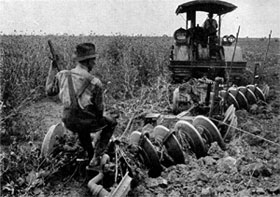The Industrial Revolution was preceded by an agricultural revolution that increased the food supply while decreasing the amount of labor needed. Comment. (250 words)
Sakshi Education
By Srirangam Sriram, Sriram's IAS, New Delhi.

Role in Industrial revolution 

Agricultural Revolution arguably started in the mid-18th century. Though the many inventions and inventors contributed to drive the Agricultural Revolution, it is also not limited to these factors alone; many other influences helped drive the agricultural revolution, and ultimately the Industrial Revolution.
Agricultural revolution
Agricultural revolution
- The traditional mode of farm production that had existed for centuries was abolished. Small, disconnected plots of land were combined into large commercial operations that implemented both new crops and the latest farming methods. Labor, machinery, fertilizer, and seed used more efficiently, thus increasing the productivity. Eventually, adoption of such methods led to the increase in the supply of food.
- Practical research had identified a number of crops that would both provide feed for animals and increase the fertility of the land. Clover and turnips were two of the most widely used for this purpose.
- The greatest social and economic impact of the agricultural revolution came from the ‘enclosure movement’, in which farmers were able to enclose their fields and grow different crops during different seasons. This drastically changed the centuries old model of the open field system, in which farmland was used in a semi-public fashion that prevented farmers from growing patterns that differed from traditional ones.
- The agricultural revolution of the time included the introduction of new crops like artificial grasses or roots, which preserved the soil’s fertility and so abolished the earlier necessity for fallow periods.
- The new system included the cultivation of forage crops. More forage meant that a larger number of livestock could be maintained, which, in turn, produced more organic manure and ensured a higher yield for the crops.
- The reliance on science and technology, the questioning of traditional methods of agriculture, and the centralization of factors of production set the stage for the onset of industrialization.
- In Britain, the fastest growth in agricultural output occurred before1760 and this growth was surpassed (or probably doubled) in 1800-30, as agriculture became more capital-intensive.
Role in Industrial revolution
- The Industrial Revolution was made possible due to the many changes and innovations in the agriculture industry. Major Contributors such as Jethro Tull and Lord Townshend found innovative ways to utilize the land and animals alongside new agricultural machines from Inventors, Robert Bakewell and James Hargreaves.
- New processes allowed for increase in food production; further with all the extra crops, inventions such as the ‘Spinning Jenny’ and the Cotton Gin allowed for the replacement of agricultural workers because machines could do more of the work.
- With a rising population and a large, cheap available work force, the Industrial Revolution was made possible. Fewer men were involved in agriculture, which meant that more would find employment in other industries further driving the Industrial Revolution.
- French agriculture increased markedly from 1815 to the early 1870s. It grew steadily and rapidly enough to feed a growing population, a decreasing proportion of which was engaged in agriculture, and to meet the demand for industrial raw materials.
- In Germany, the share of agricultural employment fell with industrialization. Germany was almost completely self-sufficient in foodstuffs till about 1850 and German farmers produced a surplus of grain, wool and timber for export.

The invention of new processes created a decline in both the intensity of the work and the number of agricultural laborers needed. Because of the decline in need for agricultural workers, many worked industrial jobs, further fueling the Industrial Revolution.
Published date : 02 Nov 2020 05:23PM






